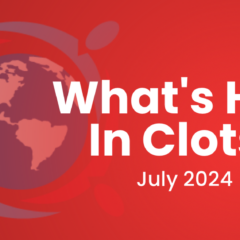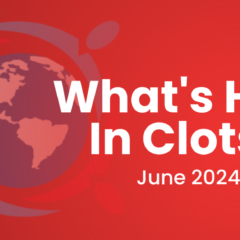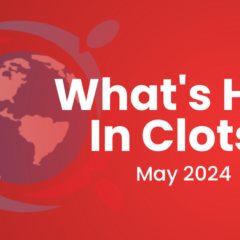Last updated on
What’s Hot in Clots – March 2023
Key Updates in Thrombosis
Table of Contents
ACC 2023 is on the horizon and there will be several interesting studies that I plan to cover next month! Here are my picks for this month:
Novel anticoagulants and very novel anticoagulants: ISTH to the rescue
The past two decades were remarkable for the management of thrombotic diseases with ‘novel’ (direct) oral anticoagulants becoming a good (frequently better) alternative to warfarin. However, we now have ‘very novel’ drugs on the horizon, including XI/XIa inhibitors and XII/XIIa inhibitors. As such, the International Society on Thrombosis and Haemostasis (ISTH) has proposed for anticoagulants to be described by their route of administration and specific target (e.g., oral Xa inhibitor, parenteral direct thrombin inhibitor). Read more
GDF-3: Upregulated in ischemia and predictive of fibrotic remodeling post-MI
An interesting translational study suggested an increase in a novel biomarker, growth differentiation factor 3 (GDF-3), after ischemia in animal models. In humans, the investigators showed that increased GDF-3 levels four days post-MI were associated with an increased risk of fibrotic cardiac remodeling as assessed by magnetic resonance imaging. Read more
Improving the validity of efficient tools for PE research in electronic databases
Many clinical research studies, large and small, rely on electronic databases for patient inclusion or identification of outcomes. Pulmonary embolism (PE) research is no exception. However, the validity of the International Classification of Diseases (ICD) codes and Natural Language Processing (NLP) tools for identification of PE patients is uncertain. The multicenter collaborative PE-EHR+ study is designed to address these gaps in knowledge. Read more
Predicting post-thrombotic syndrome
The authors used data from the pilot SAVER trial to assess the occurrence of post-thrombotic syndrome six months after an index DVT event. They found that SOX-PTS (area under the curve: 0.72) and Méan (area under of the curve: 0.74) performed reasonably well for detection of PTS. Future studies are needed to determine models with better negative vs. positive predictive values (in case one model is not excellent at both), and to explore the development of PTS during longer follow-up. Read more
Enjoy this update? Be sure to subscribe to get the latest updates each month.

Behnood Bikdeli, MD, MS
Cardiologist, Section of Vascular Medicine, Division of Cardiovascular Medicine, Brigham and Women’s Hospital
Investigator, Thrombosis Research Group, Division of Cardiovascular Medicine, Brigham and Women’s Hospital
Instructor, Harvard Medical School
Investigator, Yale/ YNHH Center for Outcomes Research and Evaluation, Yale School of Medicine
Investigator, Cardiovascular Research Foundation



